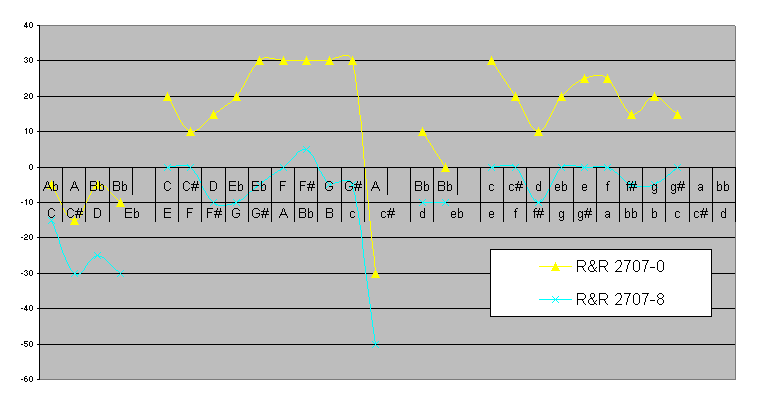A Rose by any other name?
The flute collections that have these examples of low pitch flutes by
Rudall and Rose don't always agree on what to call them. If you
look around the collection catalogues, you will see these flutes variously
described as tenors or basses, for band or chamber use, with pitches Bb,
Ab or G. Perhaps a reason for this is it isn't really
clear where these flutes fitted into musical society. It also part
of the problem that the flutes are often not in playing order and cannot
be tested.
What becomes clear from my study of these instruments is that the
flutes are all members of one family. Sure, they exist in 4 key, 6 key
and 8 key versions, but so did their D-flute counterparts. The
instruments are effectively identical from the foot upwards (apart from
the matter of two fewer keys fitted in the 6-key version). The
short foot employed in the 4-key version has a reverse taper in the
foot, but that again is normal D flute practice.

R&R 458, DCM 1410.
Note the integral head and barrel, and the short foot.
Image by Dayton
C Miller Collection, used with permission
Ideally, we need to find out what Rudall and Rose called these flutes
- they must have appeared in advertisements or catalogues
somewhere. I do note that the 1922 Rudall Carte catalogue offers
an array of "Alto flute[s] in Bb" - is this perhaps a
clue? In the interim, I'd prefer to call the instruments we're
looking at "Low Bb flutes", for these reasons:
- the normal D flute is already a tenor instrument
- I haven't found a contemporary reference to an Ab flute
- it seems unwise to base the description on the flute's lowest note
when it will depend on whether you have the 4 key
version or one of the others.
- the 6 finger note is Bb,
- the natural scale is Bb
- we need to differentiate between these and the Bb band flutes an
octave higher
- they definitely do not go down to G.
Pitch and Intonation
Many of the instruments in collecting institutions are not in playing
condition, and reverting them to playing condition would require repairs
that might devalue the instruments as study items. Fortunately,
one of the flutes in the Royal Northern College of Music was in
"as-new" condition, and I was given permission to test it for
pitch.

The curves above reveal what I found. Keep in mind that I was on the
road and so somewhat limited for facilities. I also wanted to
minimise the playing time to avoid any stress to the instrument.
So look to the big picture and don't rely on the fine details.
Both curves are for the same flute -
the yellow one for the slide fully in and the blue curve for about 8mm
extension. The horizontal scale gives the notes for a Bb flute,
and under them the fingerings for a normal flute in D, just to make it
easier to get your head around. The zero on the vertical scale is
modern pitch (A=440Hz). We can see that, at about 8mm extension,
the flute responds very well at A440, with two areas of exception:
- the foot shows the classic flat-foot syndrome we see on D flutes
of the time, in the usual proportions.
- the middle A (c# fingering) is dismally flat.
Fortunately, the maker of new instruments can easily overcome the flat foot
problem. The second one is the more interesting.
The "all-fingers-off" note (c# on a D flute, A on a Bb)
always tends flat. Ideally the top hole would be bigger and higher
up, but it also has to work for c natural and d. And it has to be
within reach. The old players got
around it by also opening the c key for c# - the additional venting eases the
c# back into place.
But this is a classical 6-key flute. There is no upper c
key. So players at the time would need to rely on their
embouchures to get that c# up into place. Fifty cents! Very
tricky! Unfortunately, I didn't get to conduct the same test on an
8-key version, but we can be sure it would solve the problem. It
raises an interesting challenge to the modern maker wishing to offer a
keyless Bb.
I trust you have enjoyed this opportunity to find out more about
these fine old flutes. I certainly enjoyed meeting them and the
people that look after them. You can find out about my own
versions of them by taking the My Flutes for
Irish Music tour.
Copyright of images
The copyright of images in this article is vested in the institutions
where the instruments reside. Images may not be used without
permission.
Acknowledgements
My thanks to the curators and staff of the institutions mentioned in
the article. My thanks also to the flute players who hosted me in
the relevant cities, and to the Australia Council and ACT Government for
their support of the tour.
On to Later Bb
Flutes or Back to McGee-Flutes
home page |